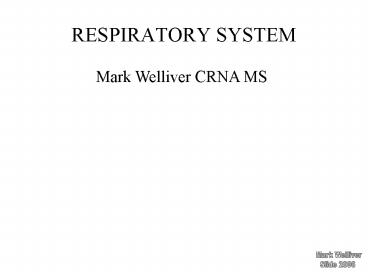RESPIRATORY SYSTEM - PowerPoint PPT Presentation
1 / 27
Title:
RESPIRATORY SYSTEM
Description:
Bicarbonate ion- Carbonic anhydrase enzyme in RBC and renal tubular cells speeds ... Carbonic acid. CO2 Transport- Bicarb. Tissue CO2 enters blood, small amt. ... – PowerPoint PPT presentation
Number of Views:327
Avg rating:3.0/5.0
Title: RESPIRATORY SYSTEM
1
RESPIRATORY SYSTEM
Mark Welliver CRNA MS
Mark Welliver Slide 2006
2
Outline
- I. Hemoglobin
- II. Oxygen carrying
- III. Carbon Dioxide carrying
- IV. Diffusion
- Haldane effect
- Bohr effect
- V. Arterial Blood Gas Analysis
Mark Welliver Slide 2006
3
Oxygen
Total body stores of oxygen 1500
ml lungs bound to hemoglobin dissolved Oxygen
Tension Tissue Hypoxia inadequate arterial O2
tension 1) hypoxemic-hypoxia-hypoxia d/t
hypoxemia 2) anemic hypoxia -inadequate O2
carrying capacity 3) circulatory hypoxia
-stagnant hypoxia poor capillary 4)
histotoxic hypoxia -failure of O2 utiliz.at
cellular level Basal Metabolic Rate O2- 250
ml/minute, producing 80
ml CO2/100ml Respiratory Quotient (RQ) 0.8 (200
ml CO2/250 ml O2 used
Mark Welliver Slide 2006
4
MM
- Oxygen ContentCaO2 dissolved O2
- CaO21.34ml/dl x Hgb x SaO2
- Dissolved0.003ml O2 x PaO2
Mark Welliver Slide 2006
5
O2 Affinity Alterations
- Carboxyhemoglobin- Carbon Monoxide 250x greater
affinity for Hgb than O2. Forms covalent bounds
with ferrous ion - Methemoglobin (Met Hb)-ferrous ion (Fe)
oxidized to Ferric state (Fe). Hgb turns
brown. Unable to bind reversibly to hgb. - Fetal Hgb (HbF)- Differs from Adult Hgb (HbA). 2
gamma polypeptide chains replace 2 beta
polypeptide chains. O2 affinity increased. Also
more easily oxidized to methemoglobin
Mark Welliver Slide 2006
6
Hemoglobin
- Hemoglobin- Main component of Red Blood Cells
(RBC) - Single RBC contains 280 million molecules Hgb
- Each Hgb molecule
- weight 64,5000
- Contains 10,000 atoms of H, C, N, O, S
- Contains 4 iron atoms (Fe) in the ferrous form
Fe
Mark Welliver Slide 2006
7
Hemoglobin Molecule
iron
heme
globin
8
Hemoglobin (heme)
- Porphyrin- 4 pyrrole rings cyclically linked by
methylene bridges - Porphyrins capable of forming covalent bonds
w/metals. - Ferrous ion (Fe) has 6 valence bonds available,
binds to 4 nitrogens on a porphyrin ring forming
heme
Mark Welliver Slide 2006
9
Heme
10
Pyrole
Mark Welliver Slide 2006
11
Porphyrin
Mark Welliver Slide 2006
12
Heme
methylene bridge
Mark Welliver Slide 2006
13
Ferrous ion Fe
Mark Welliver Slide 2006
14
Poly peptide chain
Mark Welliver Slide 2006
15
Hemoglobin
O2
CO2
Mark Welliver Slide 2006
16
Hemoglobin (globin)
- Amino Acids- 4 specific amino acid chains
(polypeptide chains), 2 alpha, 2 beta combined
form protein globin. - Globin- Contains imidazole nitrogen groups form
covalent bonds w/metals
Mark Welliver Slide 2006
17
O2 carried by Hemoglobin
O2
CO2
18
Carbon Dioxide (CO2)
- Carried in blood Three ways
- Dissolved
- Bicarbonate (combined with water)
- Carbamino compounds (combined with hemoglobin)
19
Carbon Dioxide Carriage in Blood
(HCO3-)
Mark Welliver Slide 2006
20
CO2 Transport Mechanisms
- Dissolved CO2- minimal
- Carbamino CO2 compounds- Bound to amino acids
hemoglobin. - Bicarbonate ion- Carbonic anhydrase enzyme in RBC
and renal tubular cells speeds CO2 hydration to
carbonic acid - CO2 H2O ca H2CO3 H HCO3-
Carbonic acid
Mark Welliver Slide 2006
21
CO2 Transport- Bicarb
- Tissue CO2 enters blood, small amt. remains in
physical solution (plasma), Rest diffuses into
RBC, portion binds with Hgb(carbamino-O2), 65
CO2 quickly transformed to hydrogen(H) and
bicarb(HCO3-), the hydrogen ions bind to Hgb.
Bicarb then diffuses into plasma (gradient),
Chloride ions(Cl-) migrate into RBC to maintain
electroneutrality (chloride shift)
Mark Welliver Slide 2006
22
Bohr Effect (attributed at tissue level)
- CO2 addition to blood enhances O2 release from
Hgb. It is an adaptation in animals to release
oxygen in the oxygen starved tissues of
capillaries where respiratory carbon dioxide
lowers blood pH. When blood pH decreases, the
ability of hemoglobin to bind to oxygen
decreases. Hemoglobin binds to oxygen in the
oxygen-rich atmosphere of the lungs, and releases
it in the oxygen-poor environment of the tissues.
Mark Welliver Slide 2006
23
Haldane Effect (attributed at lungs)
- O2 addition to blood enhances release of CO2 from
Hgb. O2 makes Hgb a stronger acid (less capable
of binding with H). Bicarb and carbamino
mechanisms are reversed, CO2 reformed and
diffused into alveoli, ventilated off
Mark Welliver Slide 2006
24
Mark Welliver Slide 2006
At the lung
25
?Venous side CO2 moves into plasma RBC.
?Hamburg effect (chloride shift) maintains
neutrality. ? Deoxygenated Hb 3.5 x gt
affinity for CO2
Venous capillary plasma
Red Blood Cell
?
- CO2 H2O HCO3- H
Hb
HCO3-
?
?
Cl-
HbH
Cl-
Blood already deoxygenated and on its return to
lungs
26
?pulmonary side HCO3 moves into RBC converted to
CO2. ?Hamburg effect (chloride shift)
maintains neutrality. ? Oxygen diffuses
across pulmonary membranes bind w/hb
pulmonary capillary Plasma
Red Blood Cell
Alveoli
- CO2 H2O HCO3- H
?
HCO3-
?
Cl-
Cl-
?
HbO2HbO2
O2
Blood already deoxygenated and on its return to
lungs
27
Arterial Blood Gas Analysis
- See tutorial ppt.
- Must know
Mark Welliver Slide 2006































